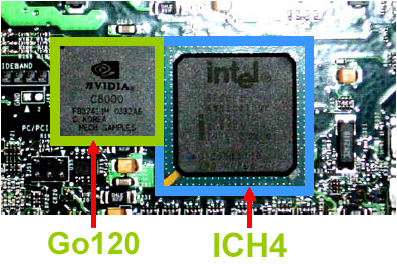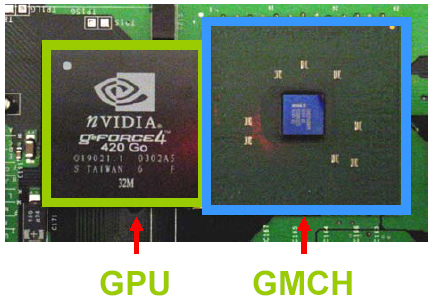NVIDIA nForce3 Go120 and Transmeta Efficeon Preview
by Andrew Ku on October 17, 2003 4:55 PM EST- Posted in
- Laptops
NVIDIA nForce3 Go120 – High Expectations
The nForce3 Go120 is focusing on the real estate issue that concerns ultraportable notebook designs. The chip is manufactured on a .15 micron process, like the higher end Go150, but has quite a small package: 22mm x 22mm. This makes it smaller than Intel’s ICH4 southbridge.

NVIDIA’s logic is that OEMs won’t have to use a northbridge and southbridge to design their ultraportable systems because the memory controller is now on the processor, in this case Transmeta’s Efficeon. The available saved space is supposed to make the nForce3 Go120 more tempting than Pentium-M solutions. There is some truth to this. While a northbridge isn’t necessary, an additional discrete graphics chip is needed, which so far as we know is going to be the GeForce4 420Go given the the target market.

Like the nForce3 Go150, the nForce3 Go120 supports ATA 133, but lacks Serial ATA and RAID support, which is perfectly appropriate since its intent is for ultraportable systems. The other specifications are very similar to the Go150 and the rest of the nForce3 family, but the nForce3 Go120 is optimized higher for low power consumption. NVIDIA tells us that an Efficeon system based on nForce3 Go120 + GeForce4 420Go will consume under 4W, while a Pentium-M based on i855GM + ICH4 consumes a little over 4.5W during Windows idle.
As we mentioned earlier, NVIDIA has some high expectations for this product. They suggested to us that OEMs could build PDAs that run with Windows XP Professional smoothly based on their chipset with the Efficeon processor. This is a high expectation, so far as no PDA we are aware of runs in this condition. (NVIDIA’s picture of a PDA running Windows XP Professional on the Go120 product page is just an artistic rendition.) The bandwidth of HyperTransport for this chip is limited at 1.6GB/s; much lower than that of the larger key nForce3 family members (nForce3 and nForce3 Go150 - 3.6GB/s).
We are very interested to see if they can stack up everything they claim. Bringing the functionality of a desktop system to fit in a pocket shirt comes with the expectation that there is a threshold for how low performance users will tolerate. This means that bringing the performance to run a Windows XP screensaver smoothly will also come with an expectation for battery life to last as long as typical systems.










1 Comments
View All Comments
Anonymous User - Tuesday, October 21, 2003 - link
(Re: nVidia+Transmeta)"Since that addition typically falls outside this focus, we currently don't see optical drives in ultraportable notebooks."
I'm surprised; this article was published 10/17/03, but the writer obviously hasn't been paying attention to the ultraportable market the past couple of years if the Fujitsu P-2000 series and current successors (P-5000, Sony TR1/2, etc.) don't receive a mention.